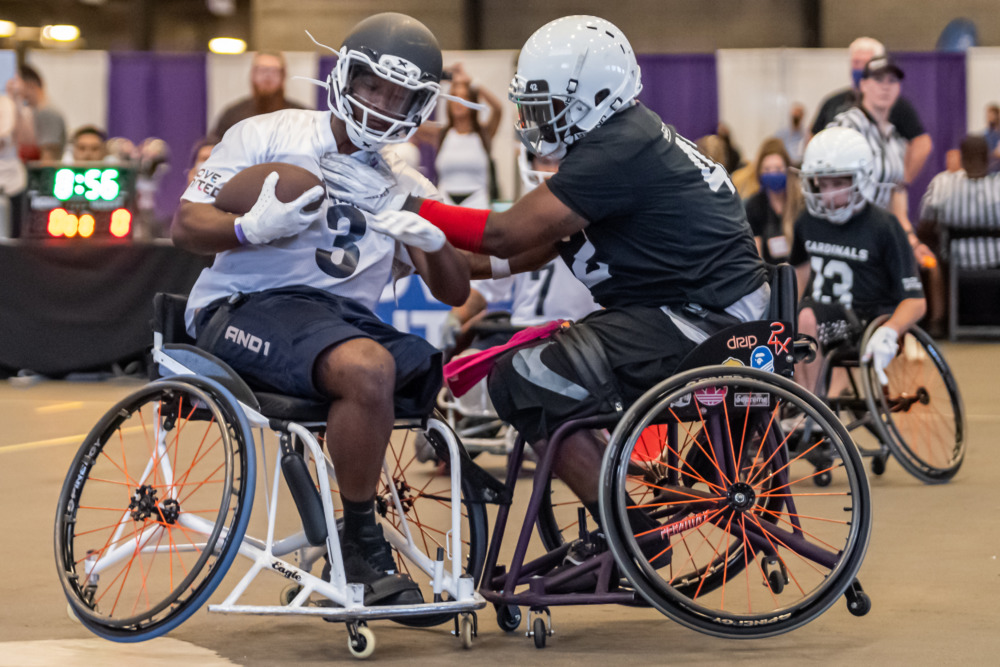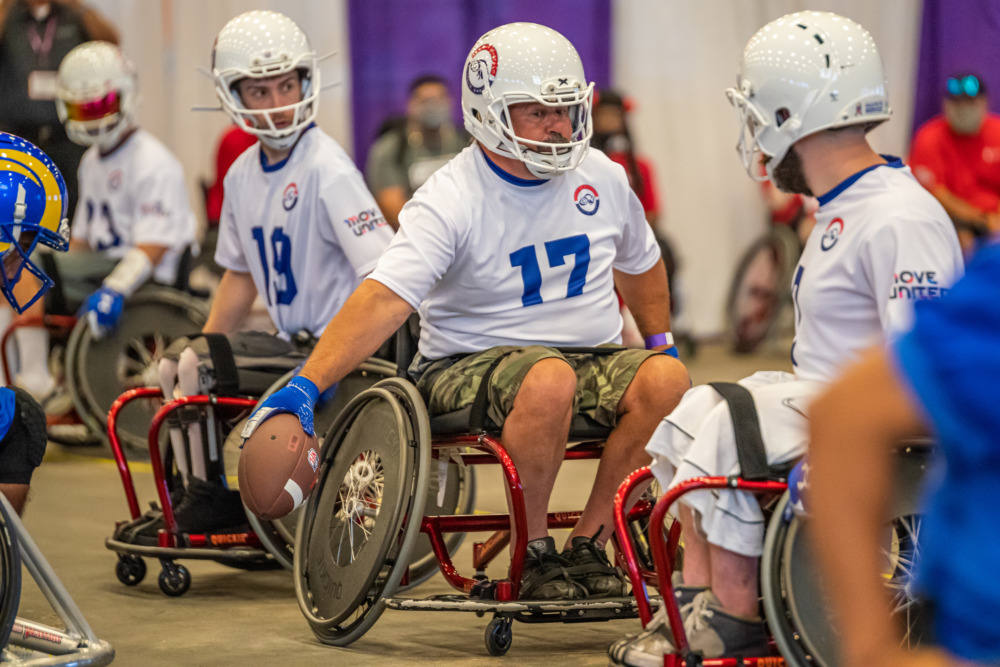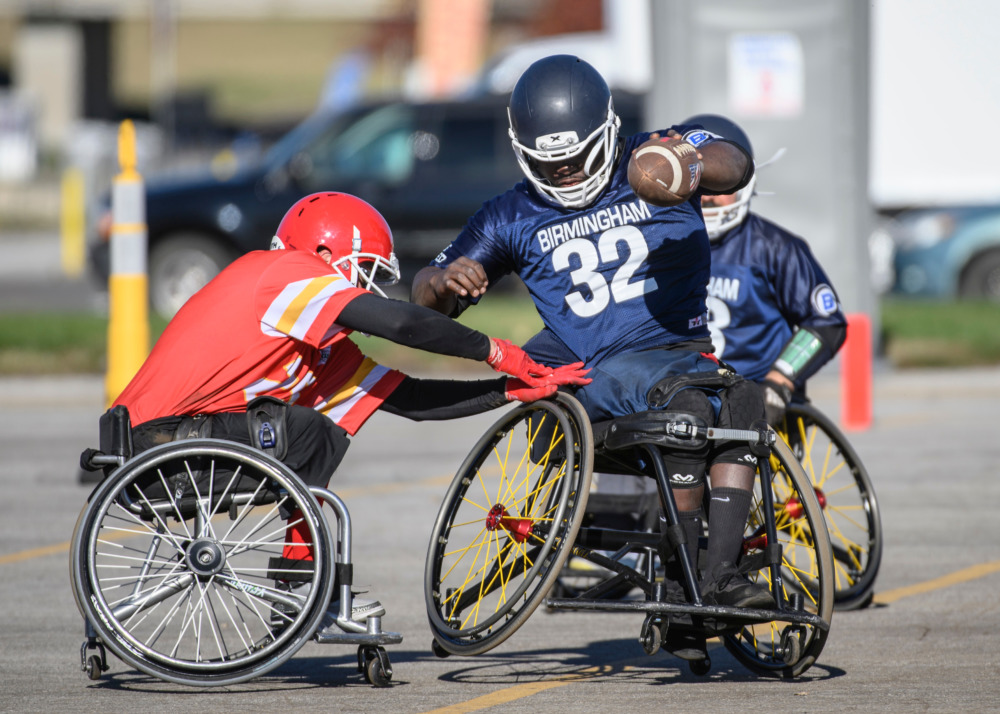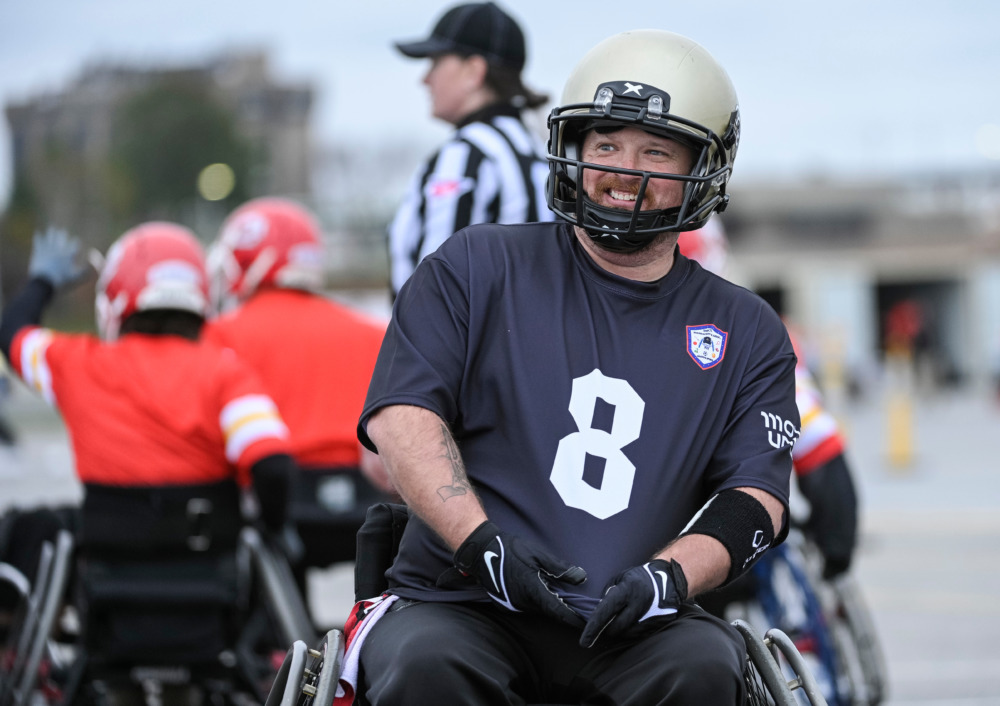As a wheelchair basketball competitor throughout high school, Kansan Riley Blee loved the mental toughness and camaraderie he derived from playing and, after graduation, found himself wishing for an ongoing outlet for his athleticism.
Two years ago, he began satisfying his craving for contact sports by signing on with the USA Wheelchair Football League, whose third season starts in August.
“I love football. I love the pace. I love contact and what’s involved.” said Blee, now 21, wide receiver/defensive back for the Kansas City Chiefs wheelchair team. “I had to play.”

courtesy of Move United
The Arizona Cardinals make a stop against the Birmingham Hammers in their 2021 game.
Touching the ball-carrier or receiver between the shoulder and hip constitutes tackles in this 11-team league. Ramming chairs is how opponents block each other.
“Some of the defenders just tried to beat me on speed,” said Blee, an Overland Park native, who has transverse myelitis, whose symptoms include leg and arm weakness. “Some of them try to beat me by roughing me up and I try to, like, overcome those people. And figuring out, like, how to get past them, how to do the right routes to get past them was really, really cool cause that’s not something you do in basketball.”
In addition to Kansas City, the Move United-launched league has players and coaches in Birmingham. Ala.; Buffalo, N.Y.; Chicago; Cleveland; Dallas, Los Angeles; Milwaukee; New Orleans, Phoenix; and Tampa, Fla. Eligible players are 18 years and older, with physical disabilities and/or mental disorders ranging from depression to post-traumatic stress disorder.
“It’s really for anyone with a disability to participate,” said Move United Senior Program Manager Karalyn Stott said. “The one caveat I think would be visual impairments. Depending on the level, safety might become a concern.”
This year, teams will compete in tournaments slated for Aug. 13 through 14 in Chicago, Aug. 27 through 28 in Tampa and Oct. 22 through 23 in Salt Lake City.

Courtesy of Move United
Buffalo’s wheelchair football team prepares to hike the ball during the 2021 Phoenix tournament in Arizona.
Hard surface floors of convention centers, gyms or parking lots are playing fields for these offensive and defensive line-ups of seven. The 60-yard fields are marked off in 15-yard increments. As in regular football, each team has four downs to reach the next marker and can do so via handoffs or passes.
While players use their hands to push the wheels of their chairs up and down the field in sports wheelchairs, they also wear helmets to shield themselves from such safety hazards as concussions.
Tampa coach Wayne Bozeman, 61, lauds this effort to give those with disabilities a chance to play one more sport.
“Because they’re in a wheelchair,” Bozeman said, “people kind of sell ‘em [short] little bit, you know: ‘Oh, you can’t play football because you’re in a wheelchair.’ But the truth of the matter is they can play the game. It’s just somebody had to come up with some rules, regulations of how to play and stuff.”
Player roles are determined by skill level
Move United’s league is designed to give wheelchair football athletes the chance to be a part of a team and can allow them to get outdoors. It aims to let them prove their versatility.
“In football, there are number of roles on the field. You don’t have to be the quarterback,” Move United manager Stott said. “You can be an offensive linemen blocking, the center snaps ball or be a wide receiver, play defense. There are a lot of positions depending on people’s skill sets, interests, all that kind of stuff.”

Courtesy of Move United
Kansas City Chiefs wheelchair football player Riley Blee reaches for the pass during practice.
The authors of a study published in June 2019 in Sports Medicine and Arthroscopy Review, noted that individuals with disabilities participate less frequently in recreational activities compared to those without disabilities. They also concluded, that regular recreational and sports activity are positively associated with quality of life, life satisfaction, community reintegration, mood and employment in those with disabilities.
A study published in January 2017 in Health and Quality of Life Outcomes and enrolling 34 18- to 62-year-old wheelchair users who regularly play adaptive sports concluded that they had a similar quality of life of similarly aged people without limited mobility.
When he was 2, a flu vaccine triggered Blee’s rare neurological condition, which is caused by inflammation of both sides of one section of the spinal cord. He could use crutches and walk during his early childhood but, as he became a teenager he switched, to a wheelchair.
Having played wheelchair basketball and wheelchair rugby, he figured he would give wheelchair football a try. The Chiefs wide receiver was named the league’s 2021 Offensive Player of the Year, largely because of his ability to move past defenders and score.

Courtesy of Move United
A Kansas City player two-hand touches a Birmingham player prior getting out of bounds during the 2021 Kansas City tournament in Kansas City, Mo.
“You’re basically going one-on-one,” Blee said. “So, [you’ve] kind of got to figure it out and figure out what’s the best strategy to get around them.”
Making crushing hits, touchdown catches or performing quick-thinking, pushing skills aren’t what captivated Tampa Bay Bucs wide receiver and safety Carlos Quintanilla Jr., though.
“It helps us people with disabilities overcome obstacles in life but through sports,” said Quintanilla, 23, who was born with spina bifida, which can cause paralysis and other nerve-related dysfunction.
Continued Quintanilla, who plays professionally for the GSD Porto Torres wheelchair basketball team in Sardinia, Italy: “… Football has taught me to communicate with others, and that’s a good life skill that’s helped me out in the real world … If there’s a miscommunication or if I notice something on the field, I can bring it up to a teammate. Or, if a teammate does something wrong, I give constructive criticism. I’ve learned not just to worry about them doing something wrong but also giving them good praise.”
***
John Groth is an award-winning writer based in Phoenix.






























